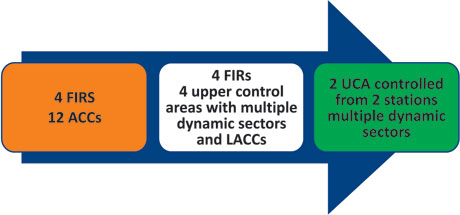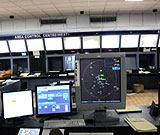|
The exponential growth witnessed in Civil Aviation in the recent past was undoubtedly of concern with
respect to skies being safe. To substantiate the statement, the hustle and bustle that we have been
hearing of and also seeing the density of air traffic increasing manifold, we thought it prudent to have a
peek into the Indian skies, thus, viewing it from the safety angle. We could not have asked for a better
person than Shri V.P. Agrawal, Chairman, AAI to give us an in-depth insight to the procedures equipment
being deployed to ensure safe and seamless transition of aircraft from Indian skies. Shri Agrawal had a
person to person interaction wherein he enriched us with the various actions executed and also on
projects on the anvil of AAI to ensure provisioning of safe skies.
|
Accordingly, we can close on an optimistic note to state that there is no cause whatsoever for any
apprehensions with regard to safety and as such “The Indian Skies are Safe” |

|
Following is the gist of the road map drawn out by the AAI Chairman:
UPPER AIRSPACE HARMONISATION
The Indian airspace is divided into five Flight information Regions (FIRs) with FIRs at Chennai, Mumbai,
Delhi, Kolkata and Guwahati. There are eleven Area Control Centres (ACCs) located at Chennai,
Hyderabad, Trivandrum and Mangalore within Chennai FIR, Mumbai, Ahmedabad and Nagpur ACCs
within Mumbai FIR, Delhi and Varanasi ACCs within Delhi FIR, Kolkata ACC and Guwahati ACC within
their respective FIRs.
 With the new generation surveillance and communication capabilities and the concept of Upper
Airspace Harmonisation, a plan has been drawn for restructuring the entire Indian airspace whereby 11
ACCs will be amalgamated into 4 ACCs initially and finally into 2 centres. Each FIR will have only one
Upper ACC centre with multiple sectors to be operated from four major ATC Centers. The entire airspace
will have overlapping surveillance cover through Radar/ADS-B/Multilateration combined with matching
seamless air-ground communication to facilitate efficient air traffic management and AIDC for ground to
ground communication. The surveillance data from Radar/ADS-B/Multilateration will be networked and
electronically processed with relevant flight data from the Flight data processor to provide an integrated
track data output correlated with flight plan so as to enable application of uniform radar separation
throughout the FIRs. With the new generation surveillance and communication capabilities and the concept of Upper
Airspace Harmonisation, a plan has been drawn for restructuring the entire Indian airspace whereby 11
ACCs will be amalgamated into 4 ACCs initially and finally into 2 centres. Each FIR will have only one
Upper ACC centre with multiple sectors to be operated from four major ATC Centers. The entire airspace
will have overlapping surveillance cover through Radar/ADS-B/Multilateration combined with matching
seamless air-ground communication to facilitate efficient air traffic management and AIDC for ground to
ground communication. The surveillance data from Radar/ADS-B/Multilateration will be networked and
electronically processed with relevant flight data from the Flight data processor to provide an integrated
track data output correlated with flight plan so as to enable application of uniform radar separation
throughout the FIRs.
With the introduction of improved ATS automation system and installation of additional Radars /ADS-B/
Multilateration, the entire continental airspace will permit seamless surveillance in addition to the
existing ADS-C over Oceanic airspace. India has successfully integrated all Radars in Chennai FIR in the
first phase thus enabling seamless upper airspace with lower limit as FL 255. The newly introduced
technique of cross coupling of VHF would facilitate creation of multiple sectorization over continental
airspace. AIDC (ATS Inter-facility data communication) enabled through Automation will substantially
reduce ATS coordination.
In the pilot project of Chennai FIR, the Uupper Airspace Harmonization includes one upper ACC centre
with five dynamic sectors, where successful integration of 10 radars including a defence radar has been
completed, and shall be operated from the Chennai ATC Center. Lateral jurisdiction of existing ACC
centers at Hyderabad, Mangalore and Trivandrum has been re-designated as Lower ACC centre with
revised lateral and vertical jurisdiction. Tower and approach will be operated from individual airports as
per the existing jurisdictions.
Similar concept of integrating Radars and upper ACC is also planned for Delhi, Mumbai and Kolkata
FIRs.This will facilitate to merge present 11 ACCs into 4 ACCs initially and finally into 2 ACCs. On successful
implementation of similar project in all the Indian FIRs, the airspace will be classified as ‘A’ aligning with
adjoining airspaces.
One of the key enablers of the upper airspace harmonization is the ATS Automation system. Flight plan /
Radar Data processing system, Airspace situation awareness track displays, Automatic co-ordination and
Hand-off, Controller Decision Support Tools, Flow management tools, Conflict detection and Safety alert
tools, route conformance warning, etc constitute an integrated ATM automation system for the
controller to handle the traffic effectively with enhanced Safety. Integrated Automation system is in
place at Mumbai, Delhi, Bangalore and Hyderabad.
Integrated Surveillance Data from multiple radars viz., Hyderabad, Chennai, Mangalore, Bangalore,
Bangalore HAL, Trivandrum, Bellary, Vishakapattnam radars is being processed by the Advanced ATS
Automation System at Chennai and the improved situational awareness support application of uniform
level of separation standards, procedures and dynamic sectorization.
CATFM (Central Air Traffic Flow Management)
An efficient ATM system should be flexible to enhance the capacity to meet the demand in an efficient
manner without adverse impact on safety and in a very cost effective manner for the airspace users.
Keeping in view the current and future growth of traffic and to ensure safe and efficient flow of traffic
through various airports and airspace, AAI has taken initiatives to implement Central Air Traffic Flow
Management system integrating interfaces of various stakeholders in the system to manage various
operational constraints strategically and tactically in such a way that the demand and capacity are
optimally balanced through collaborative decision-making process.
Stage 1 plans to operationalise the C-ATFM for the entire Indian airspace and major airports by 2012.
This would provide the ANSP, Aircraft Operator and Airlines with significant capabilities to perform
strategic, pre-tactical, and tactical ATFM and CDM, associated with sectoral demands of the Indian
Airspace and arrivals into airports, especially the high density
Chhatrapati Shivaji International Airport in
Mumbai, Indira Gandhi International Airport in New Delhi, Chennai International Airport, Netaji Subhash
Chandra Bose International Airport in Kolkata, Bangalore International Airport, and Rajiv Gandhi
International Airport in Hyderabad.
In stage 2 the Regional ATFM integration with the Indian CATFM is envisaged. The specific functionality
will be defined in collaboration with the international ANSP necessary to support the international ATFM
integration identified by AAI. These integrations can be thought in several ways. In case an adjacent FIR
of another country is not controlled by an ATFM system, this FIR can be included in AAI’s C-ATFM
system. In the case of adjacent FIRs or countries having their own ATFM system, a system-to-system
integration can be provided to improve efficiencies across both ATFM systems.
The anticipated benefits of C-ATFM when implemented in six metro airports in the first phase,
calculated based on the recent data collected on air/ground delays is presented:
• Substantial reductions in Air/ground delays in 5 metro airports per year would be 142845
minutes.
• 6 million kilogram of fuel savings annually.
• 18 million kilograms of reduction in carbon dioxide emissions per year; and
• USD 9 million airline costs savings annually.
Conclusion
Scrutiny of the facts elucidated above would clearly reveal that our aviation is in the ‘Safe Hands’ of AAI,
a congregation of professionals with a deep reservoir of expertise. As regards the licensing of Pilots, we
have intentionally not touched upon for it is beyond the preview of AAI, as it falls within the domain of
DGCA, the regulating body. Accordingly, we can close on an optimistic note to state that there is no
cause whatsoever for any apprehensions with regard to safety and as such “The Indian Skies are
Safe”.
|